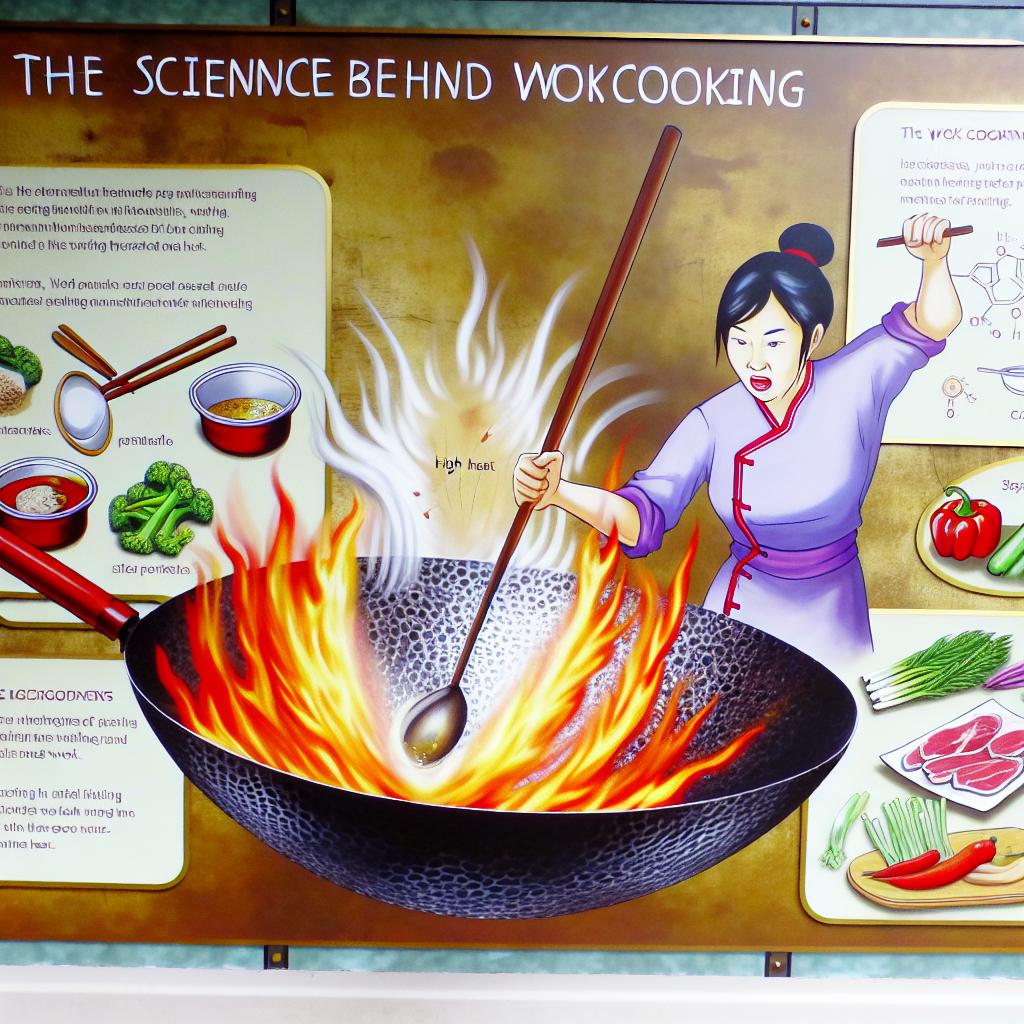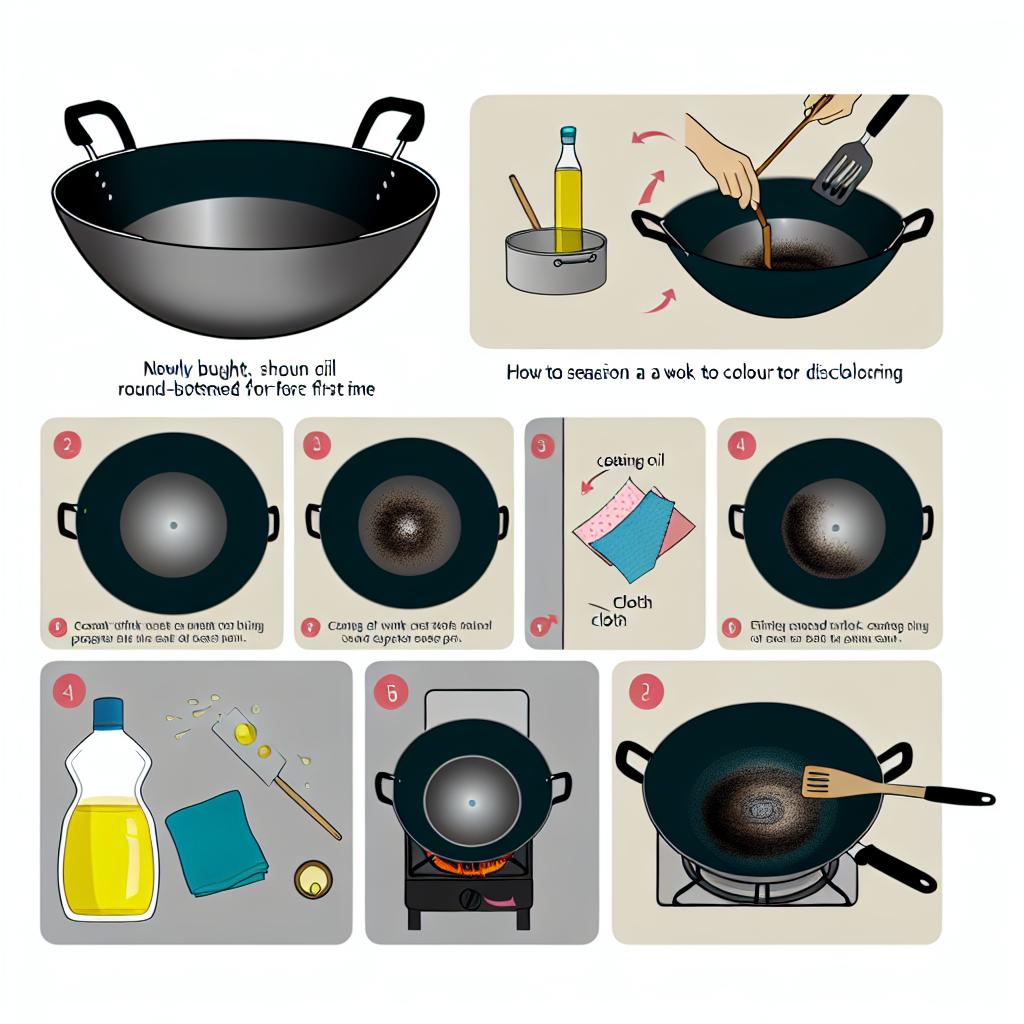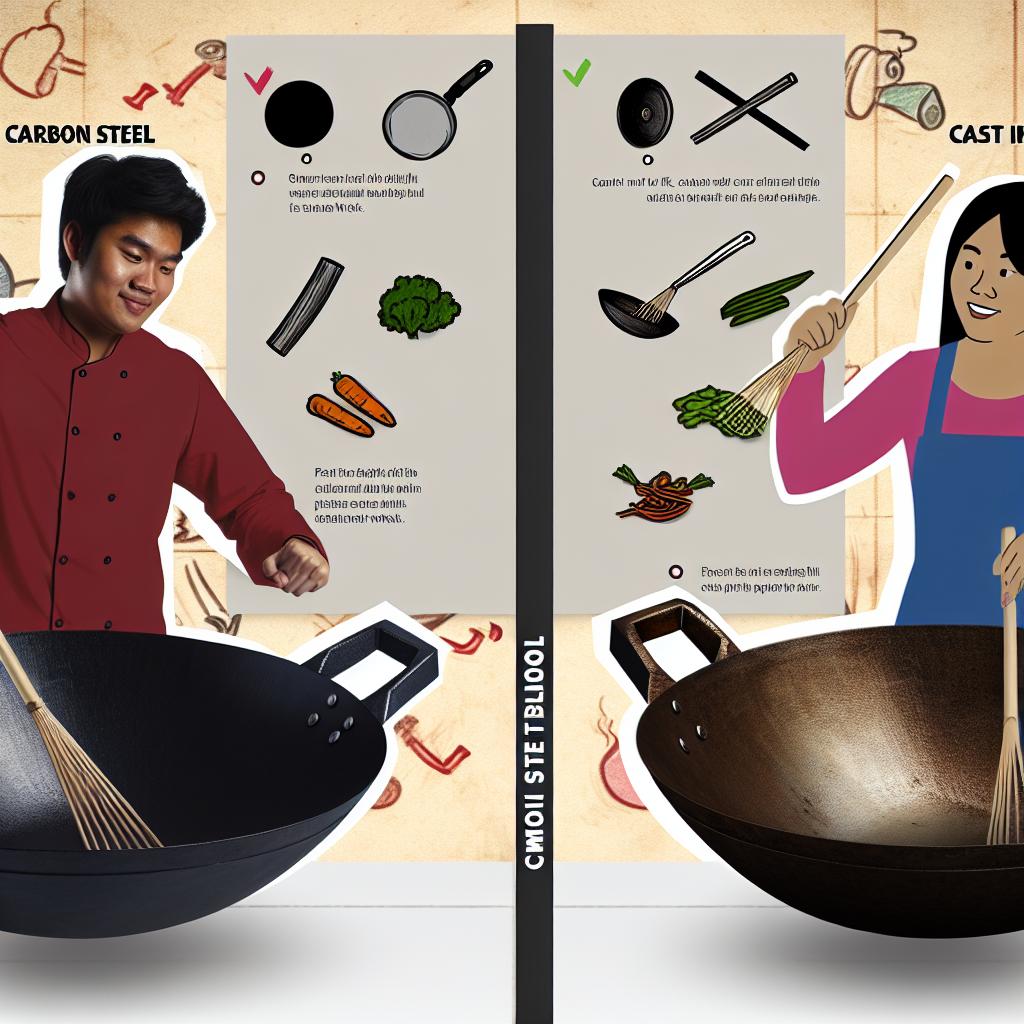The Science of Heat Distribution in Wok Cooking
Wok cooking is a cornerstone of many Asian cuisines, characterized by its unique use of high heat and specific stir-frying techniques. To create the authentic taste and texture of dishes cooked in a wok, it’s essential to understand the scientific principles that govern heat distribution within this unique cooking vessel.
The metal used in a wok is crucial in transferring heat efficiently from the source to the food being cooked. Most woks are crafted from materials like carbon steel or cast iron, both of which provide excellent heat distribution due to their conductive properties. The rounded shape and thin walls of a wok are designed for rapid heating and cooling. This characteristic is essential when preparing various dishes that require quick, high-temperature cooking, such as stir-frying, as well as those needing a consistent temperature for frying in oil.
Maillard Reaction and Flavors
At the heart of wok cooking lies the Maillard reaction, a vital chemical interaction between amino acids and reducing sugars that occurs at high temperatures. This reaction is what browns food and develops the complex flavors that are often sought after in culinary creations. When stir-frying in a wok, the high surface temperatures reached facilitate the Maillard reaction, significantly enhancing the taste and aroma of the dish. This reaction is critical for developing the rich, savory flavors that are emblematic of stir-fried foods.
Another advantage of the rapid cooking technique associated with wok use is that it prevents overcooking. Quick exposure to high heat means that vegetables maintain their vibrant colors and crispy textures. Furthermore, the brief cooking time has the added benefit of preserving the maximum amount of vitamins and nutrients, which might otherwise be lost in slower cooking methods.
The Role of Wok Hei
An essential and unique concept in wok cooking is known as wok hei, which can be translated to mean the “breath of the wok.” This term describes a complex smoky aroma and flavor attained through high-heat cooking methods. Wok hei is accomplished when various compounds within the food are vaporized and chemically altered by the intense heat, which then imparts a distinctive and highly prized flavor to the finished dish. Achieving wok hei is often considered a hallmark of excellent wok cooking and requires skill to master.
Material Selection and Its Impact
The choice of material for constructing a wok markedly influences its performance during cooking. Carbon steel and cast iron are the most common materials used, selected primarily for their superior heat conductivity and durability. As these materials wear over time, they naturally develop a non-stick patina, which can add unique flavors to food prepared in them.
Advantages of Carbon Steel
Carbon steel woks are particularly favored due to their relatively light weight, which makes them easier to maneuver during the vigorous actions involved in stir-frying. Despite their lighter weight compared to cast iron, carbon steel woks offer excellent thermal conduction, which is crucial for achieving the high temperatures needed quickly. This property makes carbon steel a popular choice for cooks who prioritize speed and agility in their cooking.
Properties of Cast Iron
On the other hand, cast iron woks, while heftier, have the advantage of retaining heat for prolonged periods. This characteristic allows them to provide a more substantial cooking surface, ideal for dishes that require extended cooking time but still benefit from high temperatures. The ability of cast iron to maintain consistent heat levels is particularly beneficial for recipes that might otherwise cool down too quickly if prepared in other materials.
Conclusion
A deep understanding of the scientific principles behind wok cooking can greatly enhance both the techniques used and the outcomes achieved in the kitchen. The strategic use of heat distribution, the chemical intricacies of the Maillard reaction, and the deliberate choice of construction materials are all pivotal in creating the quintessential flavors that define wok-prepared dishes. By appreciating these underlying factors, cooks are better able to reproduce the authentic tastes and textures that are hallmarks of this cooking style. For further reading on wok materials and their scientific properties, you may visit this resource for more information.
Introduction
When you purchase a new wok, particularly those crafted from carbon steel or cast iron, the task of seasoning it becomes a paramount step before it sees its first culinary use. The seasoning process is more than a mere preparatory measure; it’s a foundational routine that bestows a protective layer upon your wok. This layer serves dual functions: shielding the wok from rust and creating a naturally non-stick surface that is invaluable for cooking. This guide meticulously outlines each step necessary to season a wok properly upon its acquisition.
Understanding the Need for Seasoning
Seasoning is an irreplaceable process for woks made from carbon steel and cast iron. Not only does it furnish a protective layer over the surface, but it also enhances the wok’s utility by forming a polymer derived from heated oil. This process not only awards the wok with a natural non-stick property but also contributes significantly to the durability and longevity of the cookware.
The Chemistry Behind Seasoning
The process of seasoning your wok is steeped in basic chemistry. When oil is heated past its smoke point, it undergoes a transformation into a polymer. This polymer attaches itself to the wok’s surface, creating a robust, water-resistant, and durable layer that mimics the effects of traditional non-stick coatings without the chemical concerns. The polymerization ensures that food does not stick to the wok’s surface during cooking, thereby making the process of stir-frying or sautéing more efficient and delightful.
Materials Required
To properly season your wok, you will need to gather a specific set of materials:
– A new carbon steel or cast iron wok.
– A choice of cooking oil that boasts a high smoke point; suitable options include canola, grapeseed, or peanut oil.
– Paper towels or a soft cloth, which will facilitate the application of the oil.
– A scrubber or sponge for the necessary preliminary cleaning.
– A stovetop burner, which serves as the primary heat source in this process.
Step-by-Step Process
1. Cleaning the Wok
Most new woks arrive with a protective coating applied at the factory to prevent any damage during transportation. Before you embark on the seasoning process, it is crucial to remove this coating thoroughly. Begin by washing the wok with warm soapy water, employing a sponge or scrubber to cleanse both the interior and exterior surfaces. Ensuring to rinse well afterward is essential. Finally, pat the wok dry using a clean towel to prepare it for further steps.
2. Heating the Wok
Position the cleaned wok on a stove burner, setting it to medium-high heat. As the wok begins to heat, be prepared for changes in color and anticipate possible smoke emission—both are entirely typical. The objective is to heat the wok until its hue begins to transform visibly, which is indicative of it reaching the required temperature for oil application.
3. Applying Oil
Once the wok has attained the necessary heat, carefully remove it from the stove. Proceed to add a thin film of oil, ensuring that you apply it both inside and outside the surface. This is a delicate phase where using a paper towel to evenly distribute the oil is advisable. Ensure vigilance so that the oil layer remains thin, thereby avoiding any pooling of the oil, which can lead to uneven seasoning.
4. Heating the Oil
After the application of oil, return the wok to the stove, maintaining the medium-high heat setting. Allow this process to persist for approximately 10-15 minutes. During this period, it is beneficial to maneuver the wok to guarantee that all areas receive an equitable amount of heat, facilitating uniform polymerization of the oil to form the initial non-stick layer.
5. Cooling and Repeating
At the juncture where a light black or brown patina starts to manifest on the wok’s surface, remove it from the heat source and permit it to cool naturally. The effectiveness of the seasoning can be amplified by repeating this cooling and oil-heating process at least two to three times, thus reinforcing the seasoning layer.
Maintaining Your Seasoned Wok
The achievement of proper initial seasoning marks only the beginning of your journey with your wok. To sustain and enhance its non-stick surface, regular maintenance is essential. As a rule, always cleanse your wok with hot water post-use, steering clear of soap, which can strip away the seasoned layer. Following each culinary session, ensure the wok is thoroughly dried before applying a thin layer of oil once more prior to storing it. Consistency in this practice will see your wok becoming even more seasoned with continued use.
Advantages of Maintenance
Regular maintenance practices do more than preserve the seasoned surface. They also significantly reduce the risk of rust developing, keeping the wok ready for quick and efficient cooking at any time. The more you engage your wok in cooking, and by adhering to correct maintenance habits, the smoother and more effective its non-stick capabilities will become over time.
Conclusion
The practice of properly seasoning your wok is synonymous with ensuring superior cooking results and extending the lifespan of this indispensable kitchen tool. Adhering meticulously to these outlined steps allows you to build a naturally non-stick surface, perfect for stir-frying and other cooking techniques integral to Asian cuisine. With ongoing use and care, the wok will evolve into a prized possession, increasingly seasoned and efficient in its culinary applications.
Overview of Carbon Steel and Cast Iron Woks
When it comes to making delicious stir-fried dishes, choosing the right wok is essential. Two popular materials for woks are carbon steel and cast iron. Both have unique properties that can affect cooking performance, maintenance, and longevity.
Material Composition and Cooking Characteristics
Selecting a wok involves understanding the composition and cooking prowess of the materials. The difference in how carbon steel and cast iron woks are crafted plays a significant role in their functionality and efficiency.
Carbon Steel Woks
Carbon steel woks are crafted from a blend of iron and carbon. This combination imparts crucial characteristics that favor efficient cooking. Known for their lightweight construction and superb heat conductivity, carbon steel woks are celebrated by many cooking enthusiasts. The rapid heat conduction allows these woks to heat up swiftly and adjust quickly to temperature changes, making them ideal for the quick cooking style required in stir-frying. With regular and proper seasoning, the surface of a carbon steel wok can develop a natural non-stick patina, enhancing its cooking capabilities over time.
Cast Iron Woks
Conversely, cast iron woks are known for their remarkable durability and heat retention capabilities. While they take a bit longer to heat up compared to their carbon steel counterparts, they excel in maintaining stable and consistent temperatures once they are hot. This trait makes cast iron woks highly suitable for dishes that require extended, even cooking processes. Like carbon steel, cast iron also benefits from developing a seasoned surface over time, which adds a degree of non-stick capabilities and enriches the dish’s flavors.
Maintenance and Care
Proper care of woks ensures longevity and optimal cooking performance. Understanding how to maintain them is vital for any wok owner.
Seasoning
Both carbon steel and cast iron woks necessitate regular seasoning to develop and maintain a natural non-stick layer. Seasoning is not merely for better food release; it is a protective measure against rust. Over time, the seasoning can also enhance the wok’s cooking performance by imparting unique flavors to the food being prepared. Detailed seasoning techniques can be explored through useful resources like Serious Eats. Consistent seasoning ranks as one of the most crucial maintenance tasks for those looking to preserve their wok’s integrity and effectiveness.
Cleaning and Storage
The process of cleaning woks varies slightly between the two types due to their physical characteristics. Carbon steel woks, being lighter in weight, are generally easier to clean. They usually require a quick scrub and thorough drying to avoid rust formation. In contrast, the heavier cast iron woks may need more effort during cleaning, primarily because of their weight and the likelihood of residues sticking to their surfaces. Post-cleaning, both types of woks benefit from a light oil coating to uphold the seasoning layer and prevent oxidation, thus prolonging their useful life.
Weight and Maneuverability
The weight and maneuverability of a wok can significantly impact its usability in the kitchen. These features should align with the cook’s style and physical ability to handle the wok.
Carbon steel woks are generally lightweight, making them highly maneuverable. This feature caters to cooks who enjoy the agility that these woks provide. The lightness of carbon steel woks facilitates fluid tossing and stirring of ingredients, making them an excellent choice for chefs who favor dynamic cooking approaches. On the flip side, cast iron woks are notably heavier, which can be a double-edged sword. While they offer stability during cooking, their weight might present challenges when flipping ingredients or moving the wok off the heat, a factor that should be considered before making a purchase decision.
Price and Availability
The cost and availability of woks can influence the purchasing decision for both amateur and professional chefs.
Carbon steel woks tend to be more affordable, appealing to home cooks and professional chefs alike. Their availability is widespread, meaning more options in terms of brands and designs are accessible to consumers. On the other hand, cast iron woks are typically priced higher. This price reflects their inherent durability and robustness, qualities valued by those who engage in frequent or intense wok cooking. While the initial investment in a cast iron wok may be higher, its extended lifespan and cooking benefits can justify the cost in the long run.
Conclusion
Choosing between a carbon steel and a cast iron wok largely depends on the intended use and personal preference. Carbon steel woks, with their quick heating and agility, are ideal for fast-cooking techniques like stir-frying. Their lightweight nature is beneficial for cooks who prefer easily maneuverable cookware. In contrast, cast iron woks excel in heat retention and durability, lending themselves well to slow cooking or searing tasks that demand steady, prolonged heat. The choice between the two materials should align with one’s specific cooking needs and style, considering factors such as heat conduction, maintenance effort, and budget. Understanding the distinct advantages of each material ensures a personalized and fitting selection for your culinary adventures.


